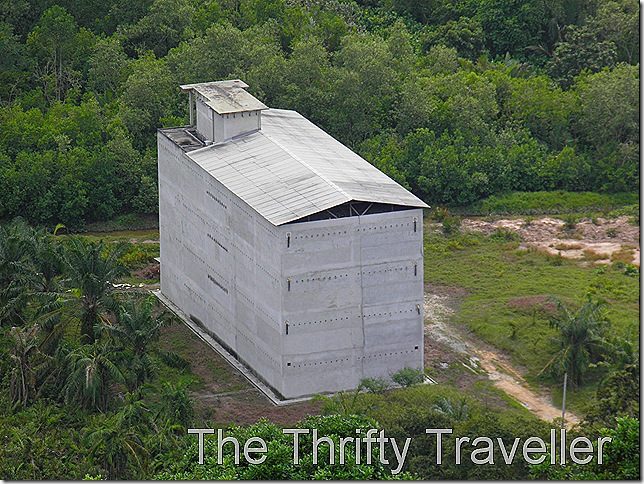Dotted around the Malaysian countryside, I often come across odd-looking buildings like this one:
With no windows, drainpipe-sized holes studded in the sides and secure metal doors, it took me a while to work out that they are birds’ nest farms.
The edible nests of the type of swiflets found in south-east Asia are the main ingredient for birds’ nest soup, the famous gourmet dish served in countless Chinese restaurants around the world. Swiftlets make nests not from sticks but from threads of their saliva which hardens on exposure to air. A bit like eating your own bogies I suppose! When washed and double boiled, usually in a chicken broth, this soup is said to have many health benefits for the skin, digestion, libido, asthma, immunity and more.
Swiftlets like to roost and breed in high and precarious nooks and crannies of caves and the job of harvesting their nests has always been hard and dangerous work which accounts for the high prices commanded by this delicacy. A kilo of birds nests (about 100 pieces) can fetch over USD5,000 when processed. High prices means the opportunity for big profits and some bright spark came up with the idea of replicating cave-like conditions in purpose-built swiftlet hotels like the one in the photo.
This idea has spawned a major birds nest harvesting industry, mainly in Indonesia (with 70% of world production), Thailand (20%) and Malaysia, a distant 3rd place (6%). The nests are sold mostly to Hong Kong, China and Taiwan.
Of course, putting up an ugly concrete block with a few holes in the side is not enough to make a successful bird nest business. The swiftlets have to be attracted inside. Expensive and sophisticated audio systems are employed to broadcast swiftlet calling songs to lure passing birds. Once inside, a different audio CD is played to simulate the sound of a cave interior full of swiftlets. It must be terribly disappointing for a swiftlet to hear all these encouraging birdsong noises only to find, after wriggling through the drainpipe, that the place is deserted. Similar to walking into an empty nightclub perhaps! And there is a third type of CD (called the dating audio) which encourages the birds to mate. Michael Buble CDs apparently have no effect on swiftlets!
These CDs are advertised on various websites costing hundreds of dollars. I don’t know if you can pick up pirate versions in Petaling Street yet.
In addition to getting the sounds right, it seems you have to spray your swiftlet hotel with pheromones (guano flavoured perfume) to make the birds feel at home.
Even with all this science, it does not guarantee financial success and, in common with many such get-rich-quick schemes, there is a high failure rate – four out of five apparently. The main reason for failure is putting up your bird house in the wrong location. And they are going up all over the place with over 5,000 in Sarawak alone. Not just in rural locations but also in converted industrial and commercial buildings and even in residential areas, much to the annoyance of the neighbours who have to put up with bird noise CDs blaring out 24 hours a day.
I wonder whether this interfering with nature by encouraging the growth of one species (swiftlets) has a distorting effect on the food chain? Swiftlets, which have echolocation abilities like bats, eat nasty flying insects like flies and mosquitoes, so that’s good, but they are also quite partial to bees, which is not so good if it leads to a bee shortage.
By the way if you are a tourist and thinking of buying birds nests as a souvenir be aware that they could be confiscated at the airport unless you have an export permit (which takes 4 days and costs RM200).



Tried Bird Nest soup last year from like http://www.geocities.jp/hongkong_bird_nest/index_e.htm . Tastes really good… yeah, I thought it was gross at first, but wow, you won’t regret it.
Thanks Lisa. I checked your link for bird nest. Expensive stuff!